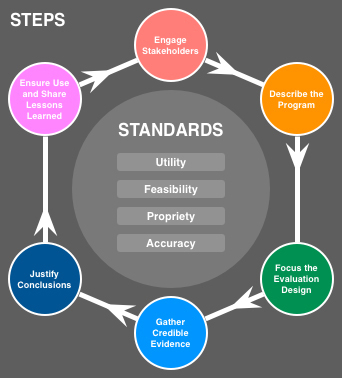Overview of CDC Framework
The CDC Program Evaluation has six steps. With your mouse, click on each step in the process, and each of the four standards for more information.
In this module, we will focus primarily on the steps entitled “Focus on the Evaluation Design” and “Gather Credible Evidence.”
Click on each of the six steps in the process, and each of the four standards for more information.
Engage stakeholders,
including those involved in program operations, those served or affected by the program, and primary users of the evaluation.
Describe the program
including the need, expected effects, activities, resources, stage context, and logic model.
Focus the evaluation design
to assess the issues of greatest concern to stakeholders while using time and resources as efficiently as possible. Consider the purpose, users, uses, questions, methods, and agreements.
Gather credible evidence
to strengthen evaluation judgments and the recommendations that follow. These aspects of evidence gathering typically affect perceptions of credibility: indicators, sources, quality, quantity, and logistics.
Justify conclusions
by linking them to the evidence gathered and judging them against agreed-upon values or standards. Justify conclusions on the basis of: standards, analysis/synthesis, interpretation, judgment, and recommendations.
Ensure use and share lessons learned
with these steps: design, preparation, feedback, follow-up, and dissemination.
Utility
Who needs the evaluation results? Will the evaluation provide relevant information in a timely manner for them?
Feasibility
Are the planned evaluation activities realistic given the time, resources, and expertise at hand?
Propriety
Does the evaluation protect the rights of individuals and the welfare of those involved? Does it engage those most directly affected by the program?
Accuracy
Will the evaluation produce findings that are valid and reliable, given the needs of those who will use the results?
Let’s explore the parts of the plan we have written so far.

